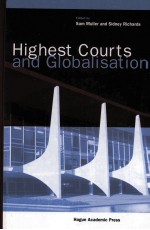图书介绍
HIGHEST COURTS AND GLOBALISATION2025|PDF|Epub|mobi|kindle电子书版本百度云盘下载

- SAM MULLER AND SIDNEY RICHARDS 著
- 出版社: HAGUE ACADEMIC PRESS
- ISBN:9067043281
- 出版时间:2010
- 标注页数:198页
- 文件大小:12MB
- 文件页数:213页
- 主题词:
PDF下载
下载说明
HIGHEST COURTS AND GLOBALISATIONPDF格式电子书版下载
下载的文件为RAR压缩包。需要使用解压软件进行解压得到PDF格式图书。建议使用BT下载工具Free Download Manager进行下载,简称FDM(免费,没有广告,支持多平台)。本站资源全部打包为BT种子。所以需要使用专业的BT下载软件进行下载。如BitComet qBittorrent uTorrent等BT下载工具。迅雷目前由于本站不是热门资源。不推荐使用!后期资源热门了。安装了迅雷也可以迅雷进行下载!
(文件页数 要大于 标注页数,上中下等多册电子书除外)
注意:本站所有压缩包均有解压码: 点击下载压缩包解压工具
图书目录
Introduction: Globalisation and Highest Courts&Sam Muller and Sidney Richards1
1. Introduction: Globalisation and the Law1
2. The Internationalisation of the Judiciary2
3. Highest Courts and Globalisation: Themes and Issues4
3.1 Unity and coherence5
3.2 Frameworks of judicial legitimacy11
3.3 Novel concepts and paradigms?13
3.4 Institutional resources18
4. Concluding Observations18
Trans-Judicial Dialogue in a Global World&Guy Canivet21
1. Introduction21
2. Why Is It Happening?23
2.1 Historical reasons23
2.1.1 Families of legal systems23
2.1.2 Strengthening legal systems25
2.2 Contextual reasons25
2.3 Political reasons28
2.4 Strategic reasons29
2.5 Utilitarian reasons29
3. How Is It Happening?30
3.1 The development of judicial diplomacy30
3.1.1 Governmental cooperation31
3.1.2 Non-governmental cooperation32
3.2 The development of the international dimension in judicial training33
3.2.1 Training33
3.2.2 Exchanges34
3.2.3 Universities35
3.3 Information and communication technology35
3.4 The development of a comparative judicial methodology36
4. How Far and within Which Parameters?37
4.1 Ideological limits37
4.1.1 Elitism37
4.1.2 Nationalism38
4.1.3 Exclusion38
4.2 Judicial limits38
4.2.1 The incommensurability of legal systems39
4.2.2 The judge's neutrality in legal training39
4.3 Institutional limits40
5. Conclusions40
The Globalisation of the Law and the Work of the Supreme Court of Canada&Michel Bastarache41
1. Introduction41
2. The Use of Non-Domestic Legal Resources in Canada42
2.1 International instruments and decisions42
2.2 Judicial borrowing46
3. Formal and Informal International Networks52
4. Conclusion54
The Widening Horizons of Litigation in Britain&Lord Bingham of Cornhill55
Judicial Co-operation and Communication in the Context of the Hague Conventions&William Duncan59
1. Introduction59
1.1 The Hague Conference on private international law59
2. The International Network of Judges60
3. Involvement of Judges in Developing and Reviewing the Operation of Hague Conventions62
4. International Judicial Conferences62
5. An International Approach to Interpretation of the Hague Conventions64
6. Conclusions65
Judicial Globalisation: Supreme Court of India&Justice Ajit Prakash Shah67
Accommodating Unity&H. Patrick Glenn85
1. Unity and Diversity85
2. Accommodating Unity88
3. Reconciling Legal Unities92
4. Conclusion97
Treating Like Cases Alike in the World: The Theoretical Basis of the Demand for Legal Unity&Jeremy Waldron99
1. A Bracing Environment99
2. The Lack of Argument100
3. Learning from Others101
4. A Need for Harmonisation?105
5. Treating Like Cases Alike107
6. The Agency Problem107
7. The Top-Down Approach108
8. The Bottom-Up Demand for Consistency109
9. The Human Rights Community110
10. Loose or Tight Consistency?112
11. Conclusion113
Justice at a New Scale: Introducing a Conceptual Framework for the Analysis of Highest Courts' Role in a Globalised Context&Elaine Mak115
1. Introduction115
2. The Changing Role of Highest Courts in a Globalised Context117
2.1 Two types of highest courts: Supreme courts and constitutional courts117
2.2 A changing role under the effects of globalisation118
2.3 The development of new practices120
3. The Theoretical Framework for the Analysis: Constitutional Flexibility121
3.1 The constitution and changing norms122
3.2 A frame of reference for a comparative constitutional law analysis123
3.3 Some methodological considerations124
4. Conclusion126
The Inevitable Globalisation of Constitutional Law&Mark Tushnet129
1. Introduction129
2. Top-Down Processes of the Globalisation of Constitutional Law131
3. Bottom-Up Processes of the Globalisation of Constitutional Law134
4. Qualifications: Counterpressures on the Supply Side138
5. Races to the Top and Bottom, and Elsewhere144
6. Conclusion: Globalisation of Domestic Constitutional Law and the Separation of Powers146
Is the Separation of Powers the Basis for the Legitimacy of an Internationalised Judiciary?&Mitchel de S.-O.-l'E. Lasser149
1. Introduction149
2. Four Objections150
2.1 The variability of the ‘separation of powers' as a concept150
2.2 The variability of the ‘judiciary' as an institution151
2.3 The variability of ‘internationalisation' as a legal context153
2.4 Difficulties with the concept of legitimacy as an abstraction156
3. Concluding Remarks: Legitimacy and Fundamental Rights158
Going Global to Preserve Domestic Accountability: The New Role of National Courts&Eyal Benvenisti and George W. Downs163
1. Introduction163
2. The Impact of Globalisation on National Decision-Making Processes164
3. Judicial Cooperation - Emerging Practice169
3.1 Reviewing global counterterrorism measures170
3.2 Environmental protection in developing countries173
3.3 Coordinating the migration into destination countries176
3.4 Protecting socio-economic rights in developing countries180
3.5 The potential of and limits to further cooperation181
4. Assessing the Legitimacy of Inter-Judicial Coordination183
5. Conclusion186
List of Contributors187
Table of Cases193